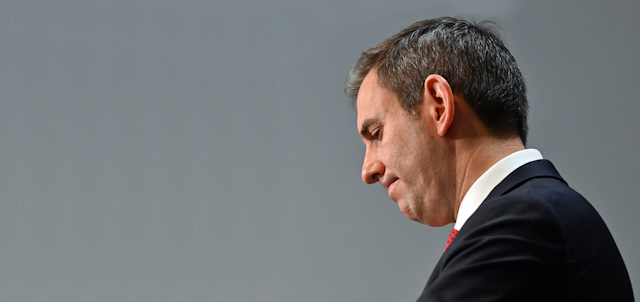Australians are set to find out if we are on the edge of a so-called “official” recession.
Due out mid-Wednesday, the national accounts will either show spending, incomes and production continued to grow in the three months to December, or show they fell.
If they fell, it would be the first of the two strikes needed for what some people call an “official” recession. (Though surprisingly, there’s no such thing here in Australia, as I’ll explain later.)
The second strike would be a fall in the following three months, the so-called March quarter. If we get two quarters in a row, all manner of people – probably including the treasurer – will declare it a recession.
But whatever Wednesday’s data shows, the truth is we are already experiencing the biggest dive in living standards in half a century – and have been for two years.
How to spot a genuine recession
The figures due out on Wednesday will give us an indication of whether ordinary Australians are better or worse off, if we know where to look.
The first thing to do is to put to one side the headline increases or falls in gross domestic product (GDP). Those are spending, income and production over the entire economy each three months.
Those figures show GDP growth was weak before the pandemic, very weak during lockdowns (shrinking for two successive quarters), then strong as lockdowns ended. It’s been exceedingly weak since.
But this tells us little about spending and income per person, which is how each of us experiences daily life.
Adjusted for our current very high rate of population growth, GDP per person is extremely weak. It’s been falling, or barely growing, for three quarters now.
And even this doesn’t tell us enough.
What matters most for each one of us – in the view of Chris Richardson, formerly of Deloitte Access Economics – is real household disposable income per capita.
Unfortunately, the bureau of statistics doesn’t display this on its website. But it’s easy enough to calculate from the bureau’s spreadsheets.
It’s the income accruing to households, adjusted for the prices paid by households, and then adjusted some more.
The bureau also subtracts taxes paid (which have climbed because of the expiry of the temporary tax offset in mid-2023). And it subtracts net interest payments, most of which are mortgage payments.
In his public presentations, Richardson says he refers to real household disposable income per capita as “living standards”, because that’s what it measures.
It shows weak spending, rising prices, a greater tax take, and much greater payments on mortgages have been shrinking living standards for two years.
That’s how it has felt for two years, even if the way the pain has been spread has been different than in the past.
The biggest dive in living standards in half a century
Previous dips in household disposable income per capita have been accompanied by high unemployment, concentrating the pain in the unlucky group looking for work at the time.
In contrast, this dip in living standards has been accompanied (so far) by low unemployment, pushing more of the burden onto working taxpayers.
Looked at through a longer-term lens (the longest the bureau’s spreadsheets allow) the latest dive in real household disposable income per capita is the biggest in half a century.
The broad picture is of fairly steady living standards until the mid-1990s, accelerating living standards during the 2000s mining boom, and then fairly flat (rising slowly) after the 2008-2009 global economic crisis.
They jumped for a bit during the COVID lockdowns, because of all the government assistance. But they’ve been diving since.
There’s no such thing as an official recession
Perhaps surprisingly, given how much we talk about “official” recessions, even the Reserve Bank of Australia says “there is no single definition of recession” here.
Many people talk about a recession meaning two quarters in a row of shrinking spending and income. This appears to date back to a 1974 New York Times article, written by a US business cycle expert Julius Shiskin.
He said two quarters of shrinking economic activity was one of the criteria you could use to decide whether or not an economy was in recession.
Shiskin’s pronouncement was subsequently latched on to by journalists all over the world, who made it the definition because it was simple.
But it has led to nonsensical conclusions.
How Australia and the US differ
Three decades ago, after the release of the September 1990 national accounts on November 29, Treasurer Paul Keating declared they showed Australia in recession.
Keating famously added:
the most important thing is this is the recession that Australia had to have.
Those words live on, but the so-called “recession” didn’t. It vanished soon after. What had been a small decline in economic activity, followed by a big decline, got revised to become a small increase, followed by a big decline.
How? The Australian Bureau of Statistics revises the national accounts as a matter of course, each time new information comes in.
Its revisions moved Australia’s early 1990s recession to the March and June quarters of 1991.
Read more: Per capita recession as Chalmers says GDP 'steady in the face of pressure'
A “recession” even briefly appeared after revisions to the 2000 national accounts, under Prime Minister John Howard and Treasurer Peter Costello. Then it disappeared, after further revisions.
In the United States, they’re not nearly as mechanical. There, there isn’t an official recession until a committee of elders convened by the National Bureau of Economic Research says so. Its proclamations have broad support.
If Wednesday’s figures show Australia’s economic activity shrinking, we will hear a lot more about an “official” recession. But it will make little difference to Treasurer Jim Chalmers as he prepares this year’s May budget.
Just like the rest of us, he knows things are going backwards.

